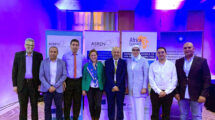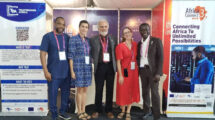Gladys Mosomtai is a passionate user of earth observation technology to solve environmental challenges, especially in Kenya. She has over five years’ experience in GIS and remote sensing applications in landscape ecology, epidemiology, movement ecology and climate change modelling. She is a PhD Fellow at the International Centre of Insect Physiology and Ecology, Kenya and the University of KwaZulu-Natal, South Africa. Her research focuses on the influence of landscape structure and microclimate on coffee pest population in smallholder farms. She has an MSc degree in Geospatial Information Science and Remote Sensing from Dedan Kimathi University of Technology, Kenya and a Bachelor’s degree in Environmental Planning and Management from Kenyatta University. She has co-authored 10 scientific publications in peer-reviewed journals and an awardee of 2018 L’Oréal-UNESCO for Women in Science Sub-Sahara Africa Fellowship. Gladys hopes to attract young women to STEM by sharing her story and mentoring girls.
Interview by Harold Bowa, UbuntuNet Alliance
You have a glittering career in STEM, what prompted you to choose a career path in this niche despite it being male dominated?
Despite aiming to be a medical doctor early on, I was inspired by one of my role models, the late Prof. Wangari Maathai, who won the Nobel Piece Prize award for her activism in protecting the environment to pursue a career in the environmental field. This coupled with my curious mind made pursuing a career as a scientist obvious for me . I was lucky to have been within an environment that nurtured my curiosity and gave me the mentorship I needed to succeed. Seeing women who were great scientists and in leadership positions subsequently allowed me to subconsciously normalize it for me that I could also one day lead an organization – it’s no longer a far-fetched dream anymore.
In my undergraduate, I picked interest in the application of remote sensing and GIS in environmental management, and this was because there was an aspect of technology in it. I fell in love with manipulating satellite images with different software to extract information on how human activities are impacting on the environment and the fact that we can see changes over time with satellite images, we can generate evidence to inform policy intervention or influence a call to action. Since then, my skills as GIS and remote sensing scientist have grown and now, I have to code and manage big earth observation data.
Now, I am at that point where the pipeline leaks the most. With a young family and currently pursuing my postdoc abroad, it’s been the most challenging part of my career but an unwavering support from my family has made it possible for me to take up this opportunity.
Part of your bio mentions that one of your goals is to help attract young women to STEM by sharing your story. Why do you think this is important?
Dreams and aspirations are informed often by the reality around us, be it a person you have seen, a story you heard or read, whichever the avenue, we can only become what we have visualized. Therefore, role models play a critical role in inspiring the next generation. The more women we have in STEM, the more girls and women in general can see themselves being scientists, engineers, physicists etc. or the more mothers can tell their daughters you can be anyone in the STEM field. It’s not enough only to see women in STEM spaces, knowing their stories too matter because it demystifies the narrative that STEM is difficult or it’s only for the brightest. Stories of successful women in STEM helps to break these mental and societal barriers and make STEM very relatable to any woman out there who wants to pursue it.
From your experience, what are some of the factors that are hindering young women from choosing a career in STEM.
Systemic cultural hindrances passed on from generations have defined women’s role as caregivers and allowed them to only pursue careers that fall or are in line with this role. On the other hand, STEM careers are deemed masculine, and girls begin to shy away from them especially when they get to teenage years. I remember back in high school when we had to choose subjects for specialization, few of us ended up choosing physics, chemistry, and biology. This would later have such an impact when choosing which career course to pursue at the university. If you didn’t have any science subject in your high school years, that automatically reduced your chances of pursuing a STEM career. Another key hindrance for women is the lack of knowledge on the diverse STEM careers available. While growing up, the mainstream career options we were all familiar with were being a doctor, pilot, police, engineer, nurse, teacher, accountant etc. and these were mainly informed by what our parents knew. If girls get to be exposed to diverse career options in STEM, especially at a young age, then we shall have a better chance of more women taking up STEM careers.
In partnership with the pan-European network, GÉANT, African RRENs are currently running an EU funded project called AfricaConnect. Apart from providing internet connectivity across the region, one of the main goals of the project is to promote women in STEM. What do you think are some of the things that should be considered in such projects in order to achieve this goal?
When projects place women’s agenda as part of their core mandate, it gives me hope that the gender gap in careers and position of power will close sooner than the 140 years estimated by the recent report of the UN WOMEN. Accelerating this progress means that research and education networks need to give visibility to successful women in STEM. This will amplify their voices and impact and normalize women being in these careers. Secondly, being seen and heard is not enough, they need to put proper mentoring structures to ensure that the leaking pipeline stops. Most women get stuck at junior or mid-level career and never able to break the glass ceiling of managerial or leadership positions. The leaky pipeline becomes inevitable when family responsibility comes into play as they become the primary caregivers. New approaches that support women with young families are needed and research and educational networks can play an instrumental role in supporting such initiatives. For instance, women can easily give up an opportunity to attend a conference or take up a scholarship to study abroad if they must leave their children behind, funding opportunities should give them an option of traveling with their families. It’s unfortunate that women go through this period in their lives where they have to choose between family or successful careers, and I hope for a world where such a burden will no longer exist.
Do you have any words of encouragement to share with fellow women in STEM and young women looking to launch their career in STEM?
Yes, I do. First, believe in yourself. Within you lies everything you need to succeed in a STEM career. Second, be your number one cheerleader. To succeed in a STEM career and in anything else in life need one to have an unwavering resolve to push through thick and thin, and that means a time will come when you have yourself in your corner. Often, these moments will determine whether you will make it or break it. I sure hope that you will look inwards and find the reason to make it.





